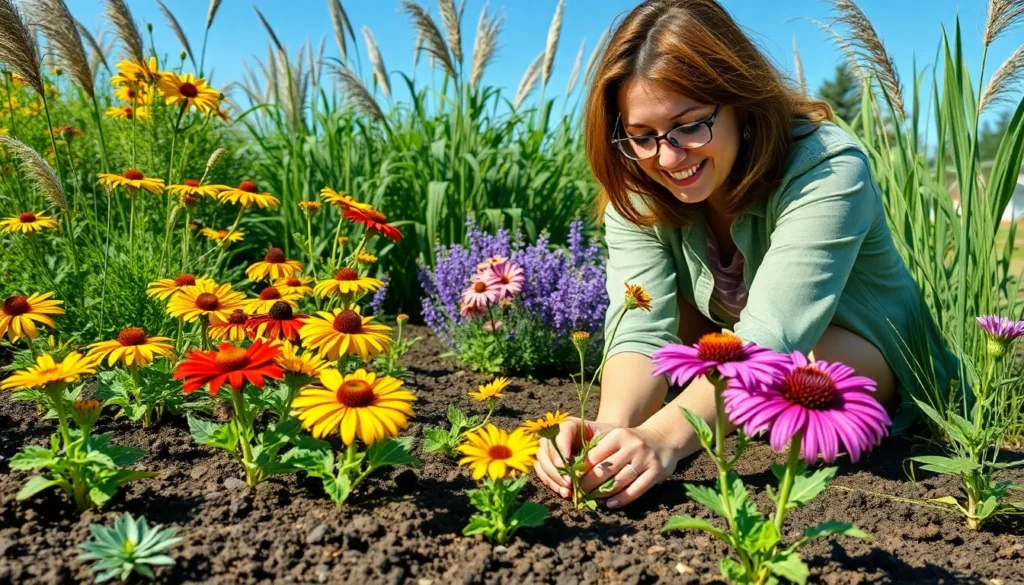Clay soil doesn’t have to be your gardening nemesis. While it’s true that heavy clay can drain poorly and become rock-hard when dry, we’ve discovered that the right plants actually thrive in these challenging conditions. Many gardeners assume they need to completely amend their clay soil before planting anything, but that’s not always necessary.
We’ve spent years testing and researching which plants naturally adapt to clay’s unique properties. The secret lies in choosing species that can handle moisture retention and compacted soil conditions. These resilient plants don’t just survive in clay – they flourish and create stunning landscapes.
Ready to transform that stubborn clay patch into a thriving garden? We’ll share our proven plant selections that work beautifully in clay soil without requiring extensive soil amendments or constant maintenance.
Understanding Clay Soil and Its Challenges for Plant Growth
Clay soil presents unique obstacles that we must recognize before selecting the right plants for our gardens.
Heavy, Dense Texture That Retains Water
Clay particles measure less than 0.002 millimeters in diameter, making them incredibly fine compared to sand or silt particles. This microscopic size creates a soil texture that feels sticky when wet and becomes rock hard when dry. We’ve observed that clay soil can hold up to 50% more water than sandy soils due to its tightly packed particle structure.
The dense composition means clay soil warms up slower in spring, often delaying planting seasons by 2-3 weeks compared to loamy soils. During wet periods, clay soil becomes waterlogged and creates muddy conditions that make garden maintenance challenging. We notice that footprints and garden tool marks remain visible for weeks after working in wet clay soil.
Poor Drainage Leading to Root Rot
Water moves through clay soil at rates as slow as 0.1 inches per hour, compared to 2-6 inches per hour in well-draining soils. This sluggish drainage creates standing water that suffocates plant roots and promotes fungal diseases. We’ve seen countless plants develop root rot when their roots sit in waterlogged clay for extended periods.
Oxygen levels in clay soil drop significantly during wet conditions, creating anaerobic environments where beneficial soil organisms cannot survive. Plants that require good drainage, such as lavender and rosemary, typically fail in clay soil because their roots cannot access the oxygen they need. We recommend checking soil moisture levels 6 inches deep before watering clay soil gardens.
Compacted Structure Limiting Root Penetration
Clay soil compacts easily under pressure from foot traffic, garden equipment, or even heavy rainfall. This compaction creates layers that roots cannot penetrate, forcing them to grow horizontally rather than establishing deep root systems. We measure clay soil compaction using a penetrometer, and readings often exceed 300 psi in heavily trafficked areas.
Compacted clay soil prevents proper root expansion, limiting nutrient uptake and water absorption even when moisture is present. Small seedlings struggle most with clay soil compaction because their tender roots lack the strength to push through dense soil layers. We avoid walking on clay soil when it’s wet to prevent additional compaction that can persist for entire growing seasons.
Native Perennials That Thrive in Clay Soil Conditions

Understanding which native perennials naturally adapt to clay soil saves us from extensive soil amendments. These hardy plants have evolved strong root systems that penetrate dense clay and tolerate variable moisture conditions.
Black-Eyed Susan for Bright Summer Color
Black-Eyed Susan (Rudbeckia hirta) brings vibrant yellow blooms with distinctive dark centers to clay soil gardens. Flowering throughout summer months, this cheerful perennial creates stunning visual impact without requiring special soil preparation. Drought tolerance develops once the plant establishes its robust root system in heavy clay conditions.
Pollinators including bees and butterflies frequently visit these bright yellow flowers, supporting local network health. We’ve observed that established Black-Eyed Susan plants continue blooming reliably even during dry spells when clay soil becomes compacted. Their adaptability makes them excellent foundation plants for clay soil gardens seeking long-lasting summer color.
Purple Coneflower for Pollinator Support
Purple Coneflower (Echinacea purpurea) stands out as one of the most successful perennials for clay soil conditions. Growing approximately 3 feet tall, these striking pink-purple flowers create dramatic garden focal points while tolerating heavy, dense soil. Monarch butterflies and native bees rely heavily on Purple Coneflower nectar throughout the growing season.
Clay soil actually benefits this native perennial by providing the consistent moisture retention it prefers. We recommend Purple Coneflower for gardeners prioritizing pollinator habitat creation in challenging clay conditions. Their exceptional clay soil tolerance combined with important pollinator value makes them essential additions to sustainable gardens.
Bee Balm for Fragrant Herb Gardens
Bee Balm (Monarda spp.) offers fragrant flower clusters in vibrant reds and purples that thrive in clay soil environments. Hummingbirds, bees, and butterflies actively seek out these aromatic blooms, making Bee Balm invaluable for pollinator gardens. Herb gardeners appreciate the plant’s dual purpose as both ornamental flower and culinary herb.
Clay soil conditions suit Bee Balm’s natural growing preferences, allowing the plant to establish strong root systems without struggling against soil compaction. We’ve found that Bee Balm’s fragrant qualities intensify when grown in moisture-retentive clay soil compared to amended soils. Their ability to attract multiple pollinator species while providing aromatic garden interest makes them perfect for clay soil herb gardens.
Ornamental Grasses Perfect for Clay Soil Gardens

Ornamental grasses bring texture, movement, and year-round structure to clay soil gardens while requiring minimal maintenance. We’ve discovered that these hardy grasses actually benefit from clay’s moisture retention properties, creating stunning prairie-style landscapes without the need for extensive soil amendments.
Switchgrass for Prairie-Style Landscaping
Switchgrass (Panicum virgatum) stands as our top choice for creating authentic prairie gardens in clay soil conditions. This native grass reaches heights of 4 to 6 feet, providing dramatic vertical structure that serves as a natural backdrop for shorter perennials. Switchgrass thrives in heavy clay because its deep root system can penetrate compacted soil layers while tolerating the moisture retention that challenges other plants.
Drought tolerance makes switchgrass incredibly low maintenance once established in clay gardens. We’ve observed that this grass requires virtually no supplemental watering after its first growing season, even in the heaviest clay soils. Wildlife benefits include providing nesting sites for birds and supporting native insects throughout the growing season.
Seasonal interest extends from spring through winter as switchgrass develops airy seed heads that catch light beautifully. Fall brings stunning color changes from green to golden yellow, orange, and burgundy tones that persist into winter months.
Little Bluestem for Fall Interest
Little Bluestem (Schizachyrium scoparium) delivers exceptional autumn color that transforms clay soil gardens into spectacular displays. This compact grass grows 2 to 4 feet tall, making it perfect for mid-border plantings where its fine texture creates visual contrast against broader-leafed perennials. Clay soil’s moisture retention supports Little Bluestem’s root development while preventing the drought stress that can limit its ornamental value.
Fall transformation begins in late summer when blue-green foliage shifts to brilliant orange, red, and copper tones. We’ve noticed that clay-grown Little Bluestem often displays more intense fall colors compared to plants in sandy soils, likely due to consistent moisture availability. Fluffy seed heads emerge in autumn, adding textural interest that persists through winter.
Low maintenance requirements make Little Bluestem ideal for busy gardeners working with clay soil. This grass tolerates foot traffic better than many ornamental species and requires only annual cutting back in late winter or early spring.
Buffalo Grass for Low-Maintenance Lawns
Buffalo Grass (Bouteloua dactyloides) offers an eco-friendly lawn alternative that actually prefers clay soil conditions over traditional turf options. This native grass forms dense, low-growing mats that reach only 4 to 6 inches in height, eliminating the need for frequent mowing. Clay soil’s compacted nature doesn’t hinder Buffalo Grass establishment since this species evolved in heavy prairie soils.
Water conservation benefits are remarkable as Buffalo Grass requires 75% less water than traditional lawn grasses once established in clay soil. We’ve documented successful Buffalo Grass lawns that receive no supplemental irrigation after their second growing season, relying entirely on natural precipitation. Mowing frequency drops to 2 to 3 times per growing season compared to weekly mowing required by conventional turf.
Durability in high-traffic areas makes Buffalo Grass excellent for family yards with clay soil challenges. This grass recovers quickly from foot traffic and maintains its appearance throughout hot summer months when traditional lawns often struggle in clay conditions.
Flowering Shrubs That Flourish in Heavy Clay
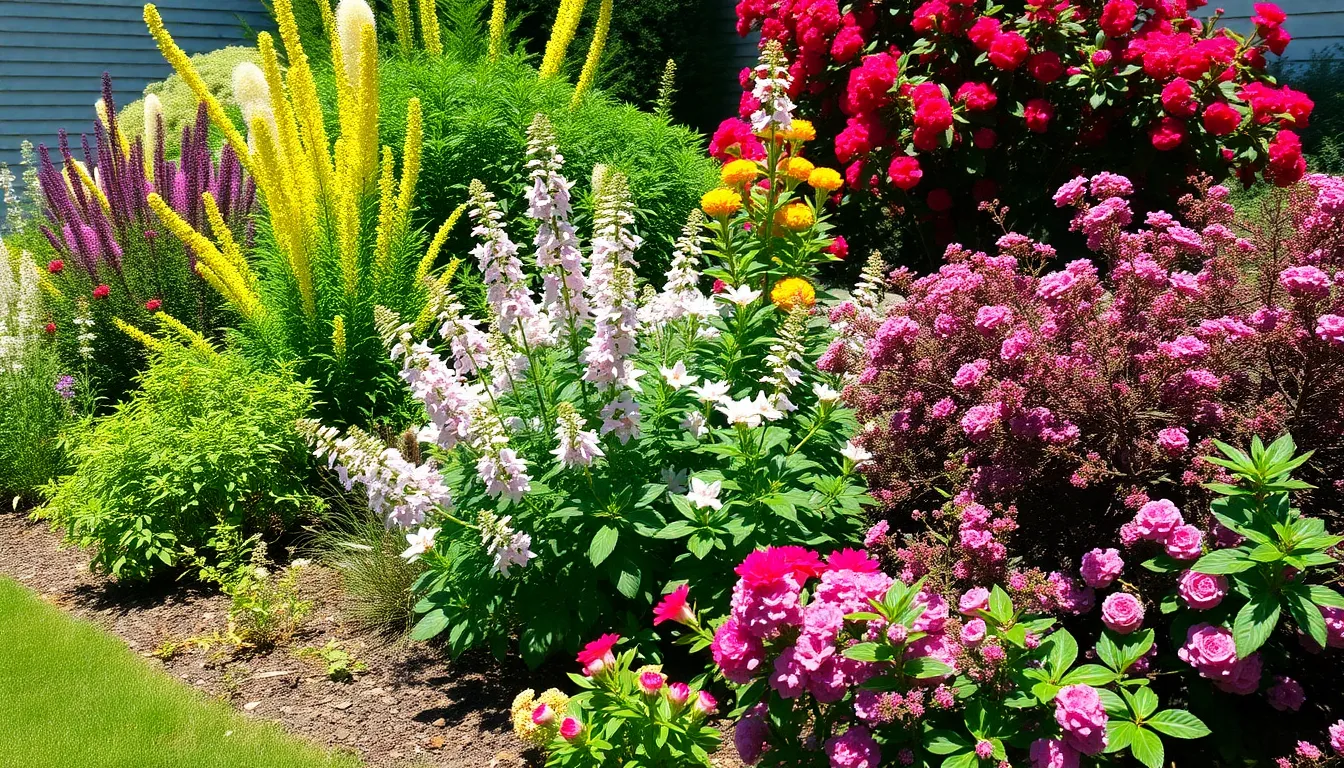
When we shift from perennials and grasses to shrubs, we discover even more options that can transform clay soil gardens into stunning landscapes. Flowering shrubs offer structure, seasonal interest, and impressive blooms while handling clay’s challenging conditions with remarkable resilience.
Spirea for Spring Blooms
Spirea adapts exceptionally well to clay soil thanks to its robust root system that penetrates compacted earth. We’ve observed how this hardy shrub produces masses of delicate white or pink flowers in spring, creating spectacular displays that brighten clay gardens. The compact, bushy growth habit makes spirea perfect for foundation plantings or mixed borders where clay soil would challenge other flowering shrubs.
Drought tolerance becomes a major advantage once spirea establishes in clay soil. Clay’s natural water retention means less frequent watering, while the shrub’s ability to handle both wet and dry conditions makes it incredibly low maintenance. Pollinators flock to spirea’s abundant blooms, adding ecological value to your clay soil industry.
Multiple varieties give us options for different garden designs and clay conditions. Bridal wreath spirea creates cascading white flowers, while Japanese spirea offers colorful foliage alongside spring blooms. These selections thrive in clay without requiring soil amendments or special care.
Ninebark for Multi-Season Appeal
Ninebark tolerates wet and compacted clay conditions better than most flowering shrubs. We recommend this native beauty for gardeners seeking year round interest in challenging clay soils. Spring brings clusters of white or pink flowers, followed by attractive seed heads that provide winter structure.
Exfoliating bark creates visual interest during dormant seasons when clay gardens need appeal most. The peeling, cinnamon colored bark adds texture and warmth to winter landscapes. Fall foliage ranges from yellow to burgundy depending on the variety, extending the shrub’s ornamental value.
Adaptability makes ninebark our top choice for clay soil landscaping projects. This resilient shrub handles everything from occasional flooding to drought conditions. Native cultivars like ‘Diablo’ and ‘Summer Wine’ offer purple foliage that contrasts beautifully with clay soil’s earthy tones.
Elderberry for Edible Landscaping
Elderberry thrives in clay soil’s naturally moist conditions, making it perfect for edible gardens. We appreciate how this productive shrub combines ornamental beauty with practical harvests. Large, flat topped clusters of creamy white flowers appear in early summer, followed by dark purple berries rich in antioxidants.
Wildlife support becomes an added benefit when growing elderberry in clay soil gardens. Birds feast on the nutritious berries, while pollinators visit the abundant flowers. This dual purpose shrub creates habitat while providing ingredients for jams, syrups, and traditional remedies.
Low maintenance requirements suit clay soil gardeners seeking productive plants without fuss. Elderberry naturally prefers the moisture retention that clay provides, reducing watering needs. Pruning in late winter keeps the shrub manageable while encouraging abundant flower and fruit production in clay soil conditions.
Shade-Tolerant Plants for Clay Soil Areas

Finding the perfect plants for shady clay soil areas can transform challenging garden spots into thriving, colorful landscapes. We’ve identified three exceptional perennials that not only tolerate but actually flourish in these demanding conditions.
Hostas for Lush Foliage
Hostas represent the ultimate choice for shade and clay soil combinations, offering unmatched versatility in low light conditions. These hardy perennials thrive in zones 3-9 and adapt beautifully to part sun through full shade environments. We love how hostas provide instant impact with their attractive foliage that comes in various colors, patterns, and shapes.
Clay soil’s moisture retention benefits hostas significantly, supporting their lush growth throughout the growing season. Their upright clumping habit creates excellent structure in shade gardens while requiring minimal maintenance. Summer blooms add an extra layer of interest, though we primarily grow hostas for their stunning foliage display.
Establishing hostas in clay areas proves remarkably straightforward since they naturally adapt to dense soil conditions. Their robust root systems gradually improve soil structure over time, making them excellent long term investments for challenging garden spots.
Astilbe for Feathery Flowers
Astilbe japonica delivers exceptional texture and color in shady clay gardens, producing distinctive feathery flowers that brighten dark corners. This shade loving perennial performs beautifully in zones 3-8 and tolerates clay soil’s heavy texture better than most flowering plants. We particularly appreciate how astilbe prefers some sun but gracefully handles full shade conditions.
Dense clay soil actually supports astilbe’s moisture requirements, creating ideal growing conditions for these stunning perennials. Their feathery plumes emerge in various colors including white, pink, and red, adding dramatic vertical interest to shade plantings. The flowers typically appear in late spring to early summer, providing extended seasonal color.
Growing astilbe in clay requires minimal soil preparation, making it perfect for gardeners wanting immediate results. These reliable performers return year after year, gradually expanding to create impressive displays in previously problematic garden areas.
Coral Bells for Colorful Leaves
Coral bells provide unmatched foliage color variation in shade and clay soil conditions, offering gardeners endless possibilities for creative combinations. These versatile perennials showcase colorful leaves in shades ranging from deep burgundy to bright lime green, creating stunning contrasts in low light areas. We find coral bells particularly valuable for their ability to maintain vibrant foliage colors even in dense shade.
Clay soil’s nutrient retention enhances coral bells’ leaf coloration, supporting the intense pigmentation that makes these plants so desirable. Their compact growth habit works perfectly in front borders or container plantings, while their tolerance for heavy soil eliminates the need for extensive amendments. The plants produce delicate flower spikes as an added bonus to their primary foliage display.
Combining coral bells with hostas and astilbe creates ever-changing shade gardens, where colorful leaves complement lush foliage and feathery flowers. This trio thrives together in clay conditions, forming the foundation for successful shade gardening without requiring soil modifications.
Trees That Adapt Well to Clay Soil Environments
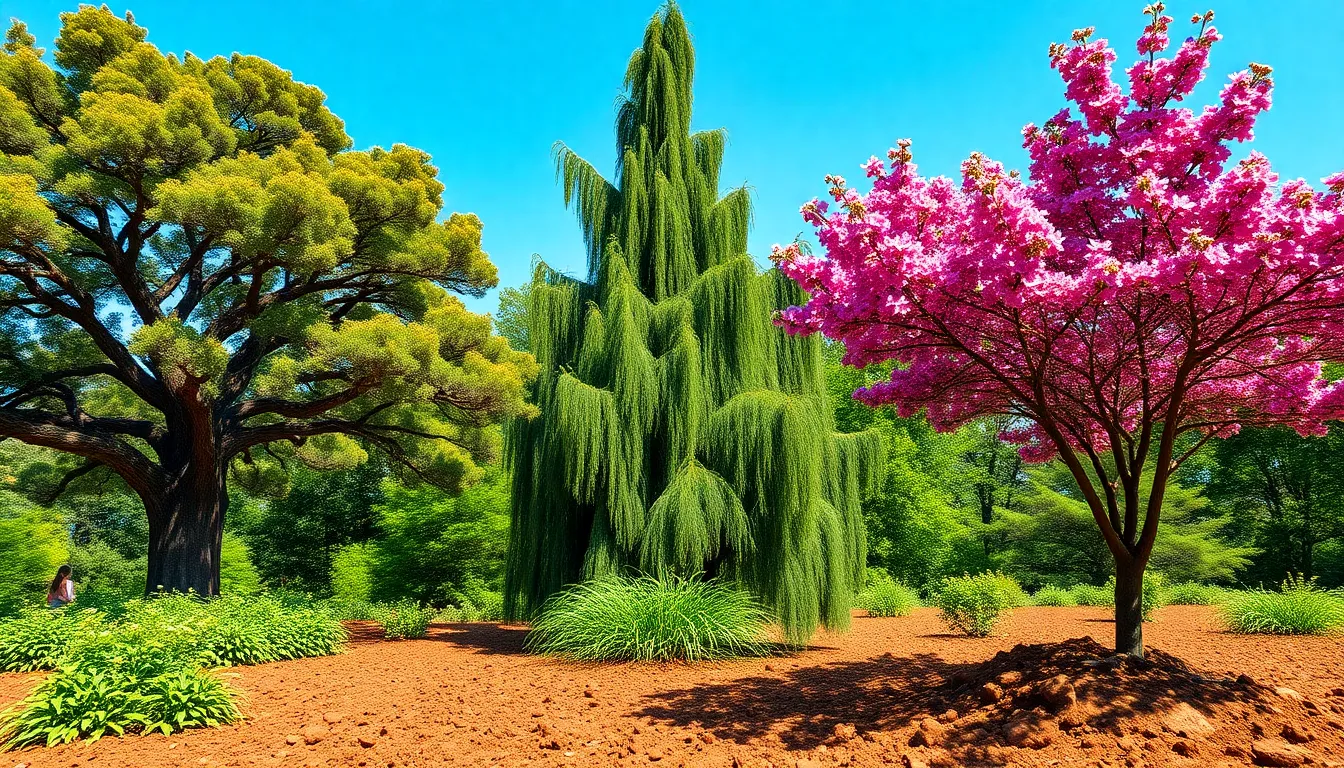
Moving beyond perennials and shrubs, we’ve discovered that certain trees can become the backbone of successful clay soil gardens. These resilient species develop robust root systems that penetrate dense clay while providing structure and long-term beauty to your industry.
Red Oak for Long-Term Shade
Red Oaks excel in clay soil environments by developing deep root systems that successfully penetrate heavy, compacted earth. We’ve observed these sturdy trees (Quercus rubra) thrive where other species struggle, making them ideal anchor plants for clay gardens. Their impressive root architecture allows them to access nutrients and water deep within clay layers, establishing strong foundations for decades of growth.
Providing exceptional long-term shade makes Red Oaks valuable investments for clay soil properties. You’ll appreciate how these trees create comfortable outdoor spaces while adapting to your soil’s challenging conditions. Their broad canopy spreads gracefully over time, offering cooling relief during hot summers without requiring soil amendments or special care.
Bald Cypress for Wet Clay Areas
Bald Cypress trees (Taxodium distichum) specialize in thriving within wet clay soils where drainage remains consistently poor. We recommend these adaptable trees for areas that stay saturated throughout growing seasons, particularly in low-lying garden spots. Their natural tolerance for waterlogged conditions makes them perfect answers for challenging clay areas that defeat other tree species.
Excelling in swampy clay soils gives Bald Cypress trees unique advantages in poorly drained landscapes. These remarkable trees actually prefer the moisture retention that clay soil provides, turning what many consider a gardening obstacle into an asset. You’ll find they establish quickly in wet clay conditions, developing distinctive buttressed trunks that add architectural interest to your garden.
Eastern Redbud for Early Spring Color
Eastern Redbuds (Cercis canadensis) deliver vibrant early spring displays with their stunning pinkish-purple blooms in clay soil gardens. We love how these small to medium-sized trees announce spring’s arrival with masses of flowers that appear directly on branches before leaves emerge. Their adaptation to various soil types, including heavy clay, makes them reliable performers in challenging growing conditions.
Adapting well to clay soil environments allows Eastern Redbuds to provide consistent spring beauty without extensive soil preparation. You’ll discover these trees establish easily in clay, developing heart-shaped leaves that complement their early flowering display. Their moderate size makes them perfect for smaller clay gardens where you want maximum seasonal impact without overwhelming the space.
Vegetables and Herbs That Grow in Clay Soil
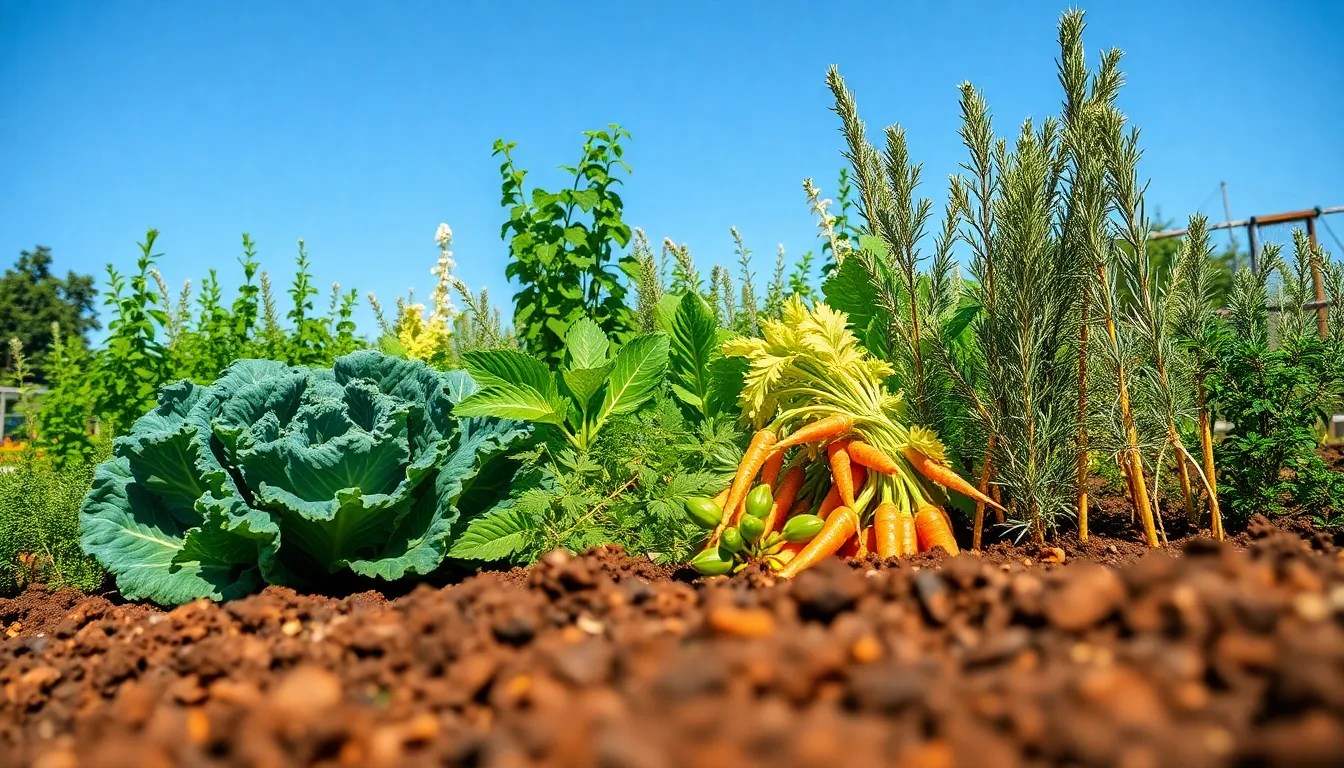
Growing food in clay soil becomes surprisingly rewarding when you choose the right varieties. We’ve found that many vegetables and herbs actually prefer clay’s nutrient-rich, moisture-retentive properties over sandy soils.
Cabbage Family Crops for Cool Weather
Cabbage family vegetables excel in clay soil conditions when grown during cooler seasons. Plants like cabbage, broccoli, cauliflower, and Brussels sprouts develop robust root systems that penetrate clay effectively while benefiting from the soil’s excellent nutrient retention. These crops thrive in early spring and fall temperatures, making them perfect for extending your growing season in clay gardens.
Cool weather helps these vegetables establish strong roots before summer heat arrives. Clay soil provides consistent moisture that prevents the stress these plants experience in sandy, fast-draining soils. Brussels sprouts particularly benefit from clay’s stability, developing larger, more flavorful sprouts when their roots can anchor firmly in the dense soil structure.
Root Vegetables That Break Up Clay
Root vegetables serve a dual purpose in clay gardens by providing food while naturally improving soil structure. Carrots, parsnips, beets, and turnips create channels as they grow, allowing better water infiltration and air circulation for future plantings. These vegetables work as living tillers, breaking up compacted layers through their natural growth process.
Selecting shorter, stockier varieties increases your success rate in clay soil. Detroit Dark Red beets and Chantenay carrots perform exceptionally well because their compact shape requires less soil displacement. Turnips and rutabagas actually prefer clay’s firmness, developing sweeter flavors when grown in moisture-retentive soil conditions.
Hardy Herbs for Culinary Use
Culinary herbs adapt remarkably well to clay soil’s challenging conditions. Salvia glutinosa, or sticky sage, thrives in clay environments with its large basal foliage and striking yellow flower spikes reaching 18-24 inches tall. This resilient herb tolerates both full sun and partial shade while providing unique culinary applications.
Rosemary develops particularly strong root systems in clay, often living for decades once established. Thyme creates dense, aromatic mats that help prevent soil erosion while providing year-round harvests. Mint varieties excel in clay’s moisture retention, though we recommend containing them to prevent aggressive spreading throughout your garden beds.
Tips for Improving Clay Soil Before Planting
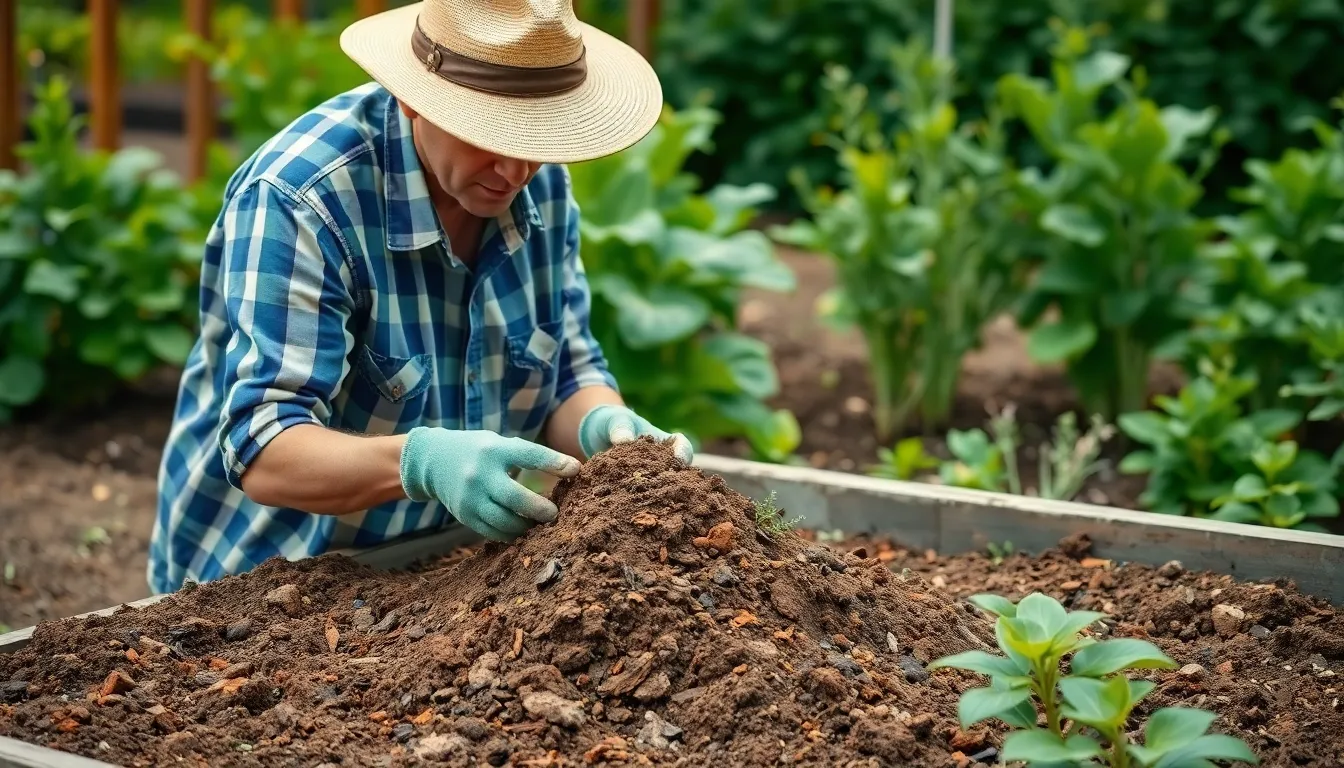
While many plants thrive naturally in clay soil, some strategic improvements can expand your planting options and enhance overall garden success. These targeted amendments will help you create the ideal growing conditions for an even wider variety of plants.
Adding Organic Matter to Enhance Drainage
Incorporating organic materials transforms clay soil structure by breaking up compacted particles and improving water flow. Compost works exceptionally well as a soil amendment, creating air pockets that allow roots to breathe and excess water to drain away. Leaf mold provides another excellent option, decomposing slowly to feed beneficial microorganisms while loosening heavy clay.
Well-rotted manure offers dual benefits by adding nutrients and improving soil texture simultaneously. We recommend working these organic materials into the top 6-8 inches of soil during fall or early spring. Adding 2-3 inches of organic matter annually will gradually transform your clay into rich, workable garden soil.
Creating Raised Beds for Better Root Health
Building raised beds eliminates many clay soil challenges by providing immediate drainage answers and preventing root suffocation. Elevated planting areas allow you to control soil quality precisely while avoiding the waterlogging that commonly affects clay gardens. Constructing beds 8-12 inches high creates adequate space for healthy root development.
Fill raised beds with a mixture of quality topsoil, compost, and drainage materials like perlite or coarse sand. This layered approach ensures your plants receive optimal growing conditions from day one. Raised beds also warm up faster in spring, extending your growing season and giving you earlier harvests.
Avoiding Common Clay Soil Mistakes
Working wet clay soil creates concrete-like compaction that can take years to remedy, so always check moisture levels before digging. Squeeze a handful of soil to test readiness; it should crumble rather than form a solid ball when squeezed. Walking on wet clay compresses the soil structure and eliminates the air spaces that roots need to thrive.
Adding sand directly to clay soil without organic matter creates an impermeable mixture similar to concrete. Instead, focus on organic amendments that naturally improve drainage while feeding soil organisms. Choosing plants naturally adapted to clay conditions eliminates the need for extensive soil modifications and ensures long-term gardening success.
Conclusion
Working with clay soil doesn’t have to be a constant struggle against nature. We’ve shown you that this dense heavy soil can actually become the foundation for a thriving diverse garden when you choose the right plants.
The key lies in embracing what clay soil offers rather than fighting against it. From drought-tolerant perennials to productive vegetables these plants have evolved to make the most of clay’s unique properties.
Whether you’re planning ornamental borders or food gardens the plant options we’ve covered prove that beautiful productive landscapes are absolutely achievable in clay conditions. Start with a few of our recommended varieties and watch your challenging soil transform into a gardening asset that supports healthy vigorous plant growth for years to come.
Frequently Asked Questions
What plants grow best in clay soil?
Native perennials like Black-Eyed Susan, Purple Coneflower, and Bee Balm thrive in clay soil. Ornamental grasses such as Switchgrass and Little Bluestem also perform well. For shade areas, Hostas, Astilbe, and Coral Bells are excellent choices. Trees like Red Oaks and Eastern Redbuds adapt beautifully to clay conditions.
Why is clay soil challenging for gardening?
Clay soil has a heavy, dense texture that retains excessive water, becoming sticky when wet and rock-hard when dry. This poor drainage can cause root rot and limits oxygen levels. The compacted structure restricts root penetration, forcing horizontal growth and limiting nutrient uptake, which delays planting seasons.
Do I need to amend clay soil before planting?
Not necessarily. Many plants naturally thrive in clay soil without extensive amendments. However, adding organic matter like compost can improve drainage and soil structure. Creating raised beds is another effective solution that eliminates many clay soil challenges while providing better growing conditions.
Can vegetables grow in clay soil?
Yes, many vegetables prefer clay soil’s nutrient-rich properties. Cabbage family crops and root vegetables perform particularly well in clay conditions. Hardy culinary herbs also thrive in clay soil, making it possible to create productive food gardens without major soil modifications.
What are common mistakes when working with clay soil?
The biggest mistakes include working wet clay soil, which causes severe compaction, and adding sand without organic matter, creating concrete-like conditions. Avoid walking on wet clay soil and always check moisture levels before working or watering to prevent further compaction issues.
How can I improve clay soil drainage naturally?
Add organic matter such as compost, well-rotted manure, or leaf mold to enhance soil structure and drainage. These materials help break up clay particles and create air pockets. Building raised beds is another effective method that provides immediate drainage improvement and better root health.

